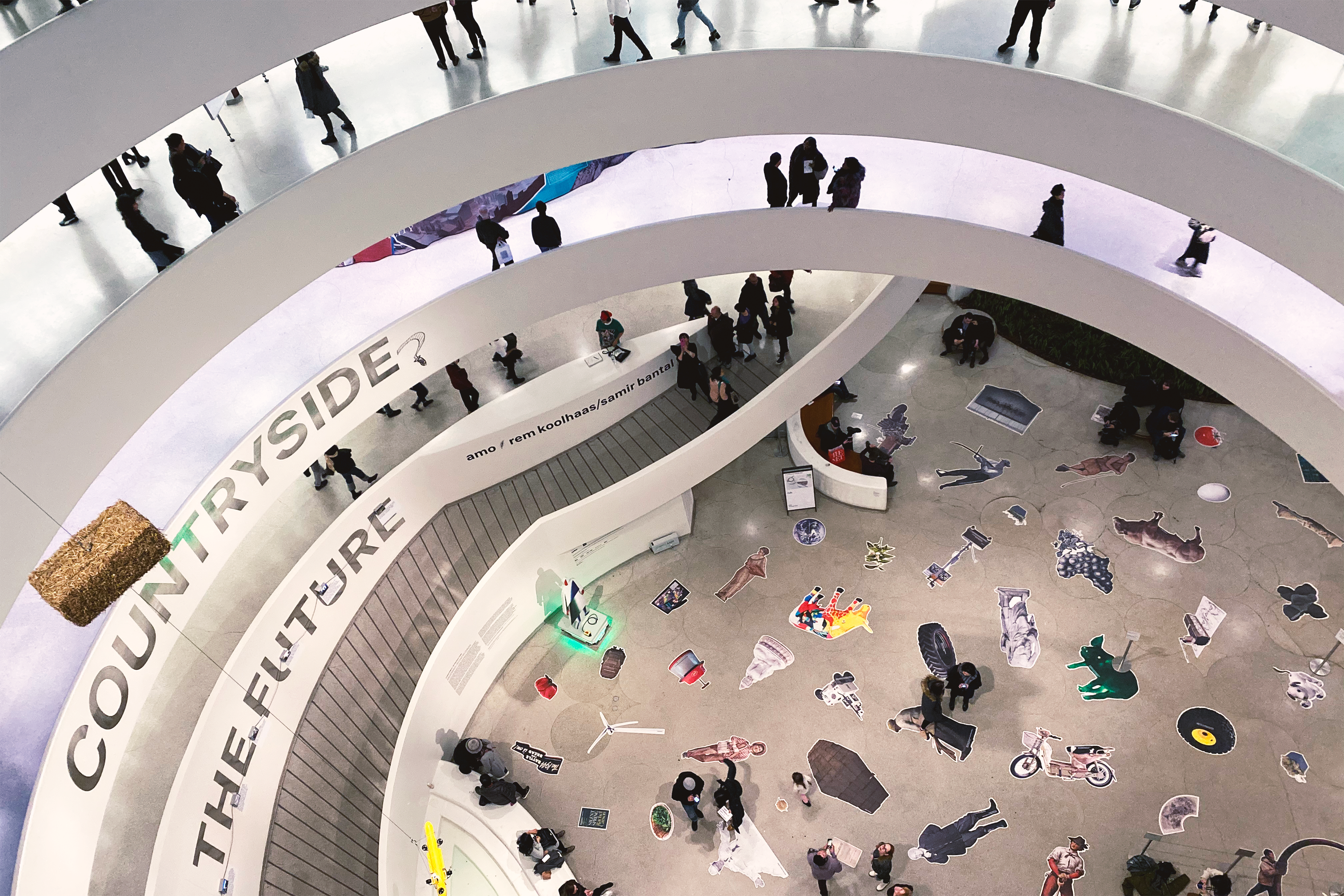06 Women Offer You Things
EXH - RES











DATE: 2017-2020
Exhibited at the Guggenheim New York, as part of the Countryside, The Future exhibition curated by OMA/AMO
Exhibited at the Guggenheim New York, as part of the Countryside, The Future exhibition curated by OMA/AMO
Brings Out The Country In You!” reads the tagline for Country Woman Magazine. But who is she?
As a media genre, magazines garner a web of criticism for their consumerist curation of stories, advertisements, and dissemination of unrealistic lifestyles. As artifacts, magazines catalog and shed light on their targeted audience, defining aspirations within that community and constructing images to be projected onto that community by outsiders.
A survey of the lineage of Country Woman Magazine covers, printed bimonthly since 1970, tells a very particular story of the country woman. A pie, a chicken, a pumpkin, a roasted turkey, a potted plant, a teddy bear, a basket of flowers, a photo album, a rabbit, an armful of puppies, a selection of gourds, a cold beverage, always a smile, the list goes on. Nearly every cover until 2015 features a smiling woman offering something. Or, in the case of this American publication, the covers feature mostly white, American women of the countryside offering something. Echoed in the suggestion of biological inevitability from the magazine’s tagline (“Brings Out The Country In You!”), these offerings appear as proof of these women’s productivity, their worth, and their fertility in the countryside.
Irish Country Magazine also often features women on its covers, but their dress, hair and makeup appear more cosmopolitan, and they are not making an offering. At first glance, female fertility and productivity seem absent from this image of the countryside but upon closer look, the covers are peppered with article titles such as “The race against time: the fertility taboo no one’s talking about,” “Pregnancy & new beginnings,” or “The last taboo: women who can’t have sex.” The Chinese magazine 크닷겟慤繫 (translates to “Rural Knowledgeable” or “Know It All Countryside”) features men on their covers who also make offerings of small farm animals.
From the imagery, stories, and advertisements hosted in these magazines, a number of gendered themes and commonalities emerge. Men are often depicted holding power tools, or in ads sitting idle on luxury sofas in front of luxury-but-still-rural fireplaces. Women are depicted in advertisements for kitchens, vacuums and other household items, or enjoying various crafts involving weaving, sewing, or cooking. Heterosexual monogamy is unanimous.
The October 4, 2017 cover of Country Life Magazine reads: “Why a love of the countryside is in our genes.” This collection of images is taken from country-themed magazines from various countries in an attempt to unpack biology, gender, and sexuality as they are culturally constructed for countryside communities and embedded in our ever-evolving understanding of the countryside.
As a media genre, magazines garner a web of criticism for their consumerist curation of stories, advertisements, and dissemination of unrealistic lifestyles. As artifacts, magazines catalog and shed light on their targeted audience, defining aspirations within that community and constructing images to be projected onto that community by outsiders.
A survey of the lineage of Country Woman Magazine covers, printed bimonthly since 1970, tells a very particular story of the country woman. A pie, a chicken, a pumpkin, a roasted turkey, a potted plant, a teddy bear, a basket of flowers, a photo album, a rabbit, an armful of puppies, a selection of gourds, a cold beverage, always a smile, the list goes on. Nearly every cover until 2015 features a smiling woman offering something. Or, in the case of this American publication, the covers feature mostly white, American women of the countryside offering something. Echoed in the suggestion of biological inevitability from the magazine’s tagline (“Brings Out The Country In You!”), these offerings appear as proof of these women’s productivity, their worth, and their fertility in the countryside.
Irish Country Magazine also often features women on its covers, but their dress, hair and makeup appear more cosmopolitan, and they are not making an offering. At first glance, female fertility and productivity seem absent from this image of the countryside but upon closer look, the covers are peppered with article titles such as “The race against time: the fertility taboo no one’s talking about,” “Pregnancy & new beginnings,” or “The last taboo: women who can’t have sex.” The Chinese magazine 크닷겟慤繫 (translates to “Rural Knowledgeable” or “Know It All Countryside”) features men on their covers who also make offerings of small farm animals.
From the imagery, stories, and advertisements hosted in these magazines, a number of gendered themes and commonalities emerge. Men are often depicted holding power tools, or in ads sitting idle on luxury sofas in front of luxury-but-still-rural fireplaces. Women are depicted in advertisements for kitchens, vacuums and other household items, or enjoying various crafts involving weaving, sewing, or cooking. Heterosexual monogamy is unanimous.
The October 4, 2017 cover of Country Life Magazine reads: “Why a love of the countryside is in our genes.” This collection of images is taken from country-themed magazines from various countries in an attempt to unpack biology, gender, and sexuality as they are culturally constructed for countryside communities and embedded in our ever-evolving understanding of the countryside.